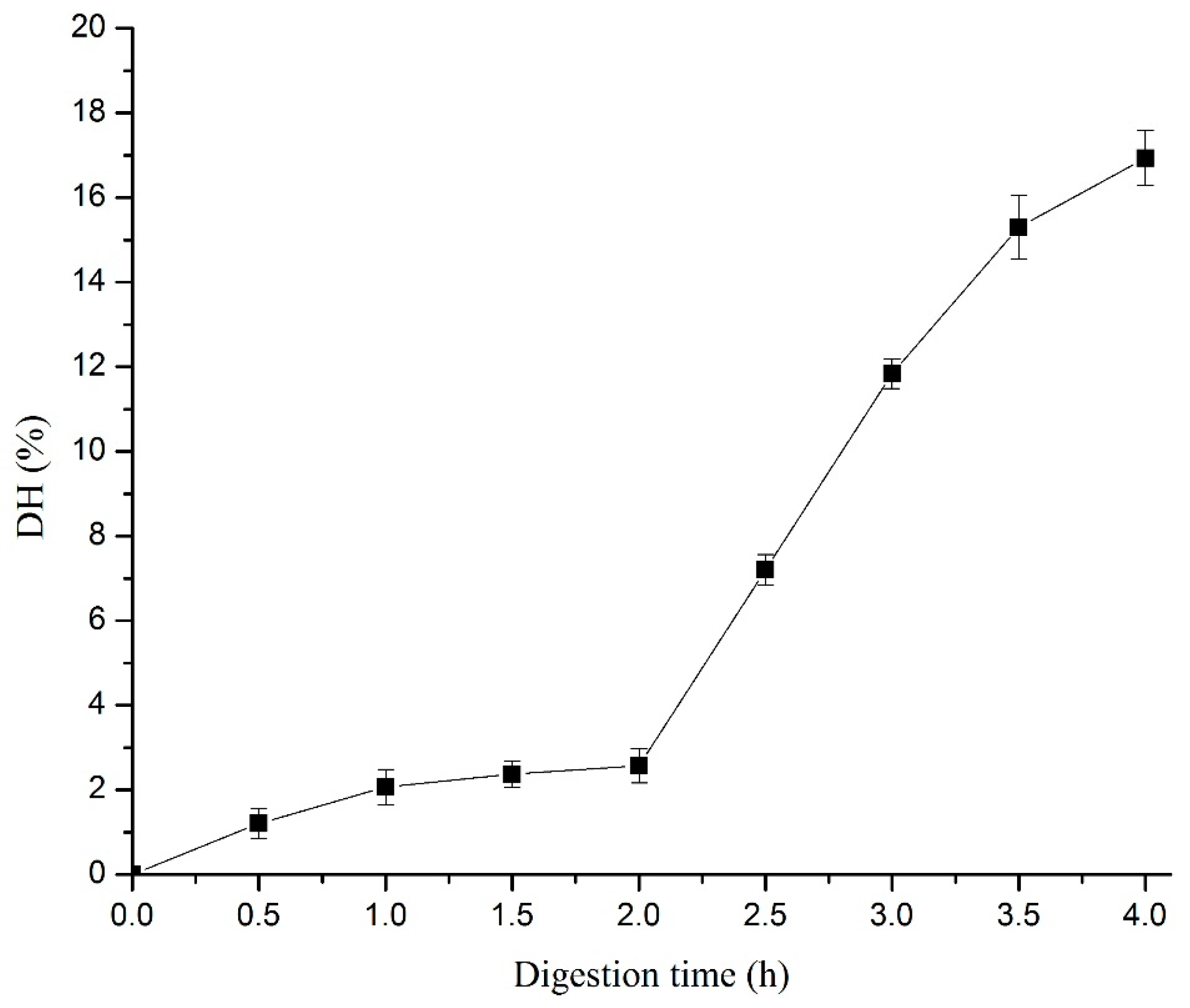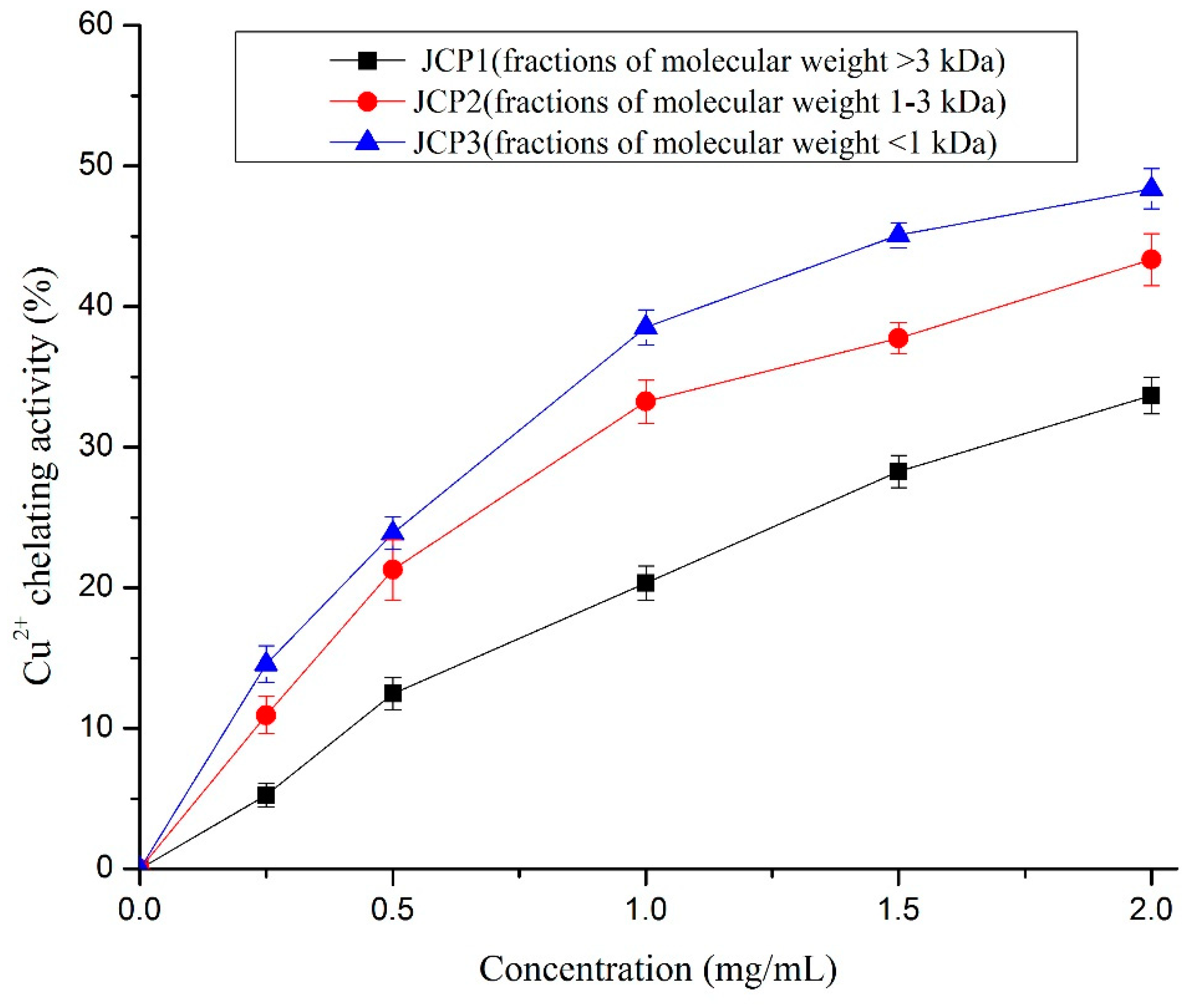In Vitro Antioxidant Activity of Peptides from Simulated Gastro-Intestinal Digestion Products of Cyprinus carpio haematopterus Scale Gelatin
Abstract
:1. Introduction
2. Materials and Methods
2.1. Materials
2.2. Chemicals and Reagents
2.3. In Vitro Simulated GI Digestion
2.4. Measurement of Hydrolysis Degree (DH)
2.5. Measurement of Consituents of Cyprinus Carpio Haematopterus Scale
2.6. Isolation of Peptide Fractions from GI Digestion
2.7. Determination of Antioxidant Activities
2.7.1. Hydroxyl Radical Scavenging Activity Assay
2.7.2. DPPH Radical Scavenging Activity Assay
2.7.3. Reducing Power Assay
2.7.4. Metal Chelating Activity
2.7.5. Measurements of the Lipid Peroxidation Inhibition Activity
3. Results and Discussion
3.1. The Basic Components of Cyprinus Carpio Haematopterus Scale
3.2. DH of GI Digests
3.3. Molecular Weight Distribution of GI Digestion
3.4. Antioxidant Activities of Cyprinus carpio haematopterus Scale Gelatin Digested Products
3.4.1. Hydroxyl Radical Scavenging Activity
3.4.2. DPPH Radical Scavenging Activity
3.4.3. Reducing Power
3.4.4. Chelating Activity of Cu2+
3.4.5. Lipid Peroxidation Inhibition Activity
4. Conclusions
Author Contributions
Funding
Conflicts of Interest
Abbreviations
| GI | gastro-intestinal |
| DPPH | 1,1-diphenyl-2-picrylhydrazyl |
| DH | hydrolysis degree |
| JCP1 | >3 kDa fraction isolated Cyprinus carpio haematopterus scale gelatin digested products |
| JCP2 | 1–3 kDa fraction isolated Cyprinus carpio haematopterus scale gelatin digested products |
| JCP3 | <1 kDa fraction isolated Cyprinus carpio haematopterus scale gelatin digested products |
References
- Ogawa, M.; Moody, M.W.; Portier, R.J.; Bell, J.; Schexnayder, M.A.; Losso, J.N. Biochemical properties of black drum and sheepshead seabream skin collagen. J. Agric. Food Chem. 2003, 51, 8088–8092. [Google Scholar] [CrossRef]
- Jeevithan, E.; Wu, W.; Nanping, W.; Lan, H.; Bao, B. Isolation, purification and characterization of pepsin soluble collagen isolated from silvertip shark (Carcharhinus albimarginatus) skeletal and head bone. Process Biochem. 2014, 49, 1767–1777. [Google Scholar] [CrossRef]
- Liu, D.; Wei, G.; Li, T.; Hu, J.; Lu, N.; Regenstein, J.M.; Zhou, P. Effects of alkaline pretreatments and acid extraction conditions on the acid-soluble collagen from grass carp (Ctenopharyngodon idella) skin. Food Chem. 2015, 172, 836–843. [Google Scholar] [CrossRef]
- Minh Thuy, L.T.; Okazaki, E.; Osako, K. Isolation and characterization of acid-soluble collagen from the scales of marine fishes from Japan and Vietnam. Food Chem. 2015, 149, 264–270. [Google Scholar] [CrossRef]
- Veeruraj, A.; Arumugam, M.; Ajithkumar, T.; Balasubramanian, T. Isolation and characterization of collagen from the outer skin of squid (Doryteuthis singhalensis). Food Hydrocoll. 2015, 43, 708–716. [Google Scholar] [CrossRef]
- Xiao, F.; Zhu, W.X.; Qiu, Y.Y.; Kang, H.B. Optimization of demineralization on Cyprinus carpio haematopterus scale by response surface methodology. J. Food Sci. Technol. 2015, 52, 1684–1690. [Google Scholar]
- Yang, B.; Yang, H.; Li, J.; Li, Z.; Jiang, Y. Amino acid composition, molecular weight distribution and antioxidant activity of protein hydrolysates of soy sauce lees. Food Chem. 2011, 124, 551–555. [Google Scholar] [CrossRef]
- Zhao, J.; Xiong, Y.L. Interfacial peptide partitioning and undiminished antioxidative and emulsifying activity of oxidatively stressed soy protein hydrolysate in an O/W emulsion. LWT-Food Sci. Technol. 2015, 61, 322–329. [Google Scholar] [CrossRef]
- De Gobba, C.; Tompa, G.; Otte, J. Bioactive peptides from caseins released by cold active proteolytic enzymes from Arsukibacterium ikkense. Food Chem. 2014, 165, 205–215. [Google Scholar] [CrossRef]
- Shanmugam, V.P.; Kapila, S.; Sonfack, T.K.; Kapila, R. Antioxidative peptide derived from enzymatic digestion of buffalo casein. Int. Dairy J. 2015, 42, 1–5. [Google Scholar] [CrossRef]
- Sun, S.G.; Niu, H.H.; Yang, T.; Lin, Q.L.; Luo, F.J.; Ma, M.H. Antioxidant and anti-fatigue activities of egg white peptides prepared by pepsin digestion. J. Sci. Food Agric. 2014, 94, 3195–3200. [Google Scholar] [CrossRef]
- Li, T.F.; Ye, B.; Song, L.Y.; Yu, R.M. Isolation and purification of two antioxidant peptides from alcalase hydrolysate of Arca subcrenata. J. Chin. Med. Mater. 2014, 37, 1140–1144. [Google Scholar]
- Umayaparvathi, S.; Arumugam, M.; Meenakshi, S.; Drager, G.; Kirschning, A.; Balasubramanian, T. Purification and Characterization of Antioxidant Peptides from Oyster (Saccostrea cucullata) Hydrolysate and the Anticancer Activity of Hydrolysate on Human Colon Cancer Cell Lines. Int. J. Pept. Res. Ther. 2014, 20, 231–243. [Google Scholar] [CrossRef]
- Wang, B.; Wang, Y.M.; Chi, C.F.; Luo, H.Y.; Deng, S.G.; Ma, J.Y. Isolation and Characterization of Collagen and Antioxidant Collagen Peptides from Scales of Croceine Croaker (Pseudosciaena crocea). Mar. Drugs 2013, 11, 4641–4661. [Google Scholar] [CrossRef]
- Cross, C.E.; Halliwell, B.; Borish, E.T.; Pryor, W.A.; Ames, B.N.; Saul, R.L.; McCord, J.M.; Harman, D. Oxygen radicals and human disease. Ann. Intern. Med. 1987, 107, 526–545. [Google Scholar] [CrossRef]
- Moskovitz, J.; Yim, M.B.; Chock, P.B. Free Radicals and Disease. Arch. Biochem. Biophys. 2002, 397, 354–359. [Google Scholar] [CrossRef]
- Gómez-Guillén, M.C.; Giménez, B.; López-Caballero, M.E.; Montero, M.P. Functional and bioactive properties of collagen and gelatin from alternative sources: A review. Food Hydrocoll. 2011, 25, 1813–1827. [Google Scholar] [CrossRef]
- You, L.; Zhao, M.; Regenstein, J.M.; Ren, J. Changes in the antioxidant activity of loach (Misgurnus anguillicaudatus) protein hydrolysates during a simulated gastrointestinal digestion. Food Chem. 2010, 120, 810–816. [Google Scholar] [CrossRef]
- Sun, S.W.; Lin, Y.C.; Weng, Y.M.; Chen, M.J. Efficiency improvements on ninhydrin method for amino acid quantification. J. Food Compos. Anal. 2006, 19, 112–117. [Google Scholar] [CrossRef]
- Xiang, J.; Zhang, M.; Apea-Bah, F.; Beta, T. Hydroxycinnamic acid amide (HCAA) derivatives, flavonoid C-glycosides, phenolic acids and antioxidant properties of foxtail millet. Food Chem. 2019, 295, 214–223. [Google Scholar] [CrossRef]
- Xiang, J.; Yang, C.; Beta, T.; Liu, S.; Yang, R. Phenolic Profile and Antioxidant Activity of the Edible Tree Peony Flower and Underlying Mechanisms of Preventive Effect on H2O2-Induced Oxidative Damage in Caco-2 Cells. Foods 2019, 8, 471. [Google Scholar] [CrossRef]
- Xie, Z.; Huang, J.; Xu, X.; Jin, Z. Antioxidant activity of peptides isolated from alfalfa leaf protein hydrolysate. Food Chem. 2008, 111, 370–376. [Google Scholar] [CrossRef]
- Liu, D.; Liang, L.; Regenstein, J.M.; Zhou, P. Extraction and characterisation of pepsin-solubilised collagen from fins, scales, skins, bones and swim bladders of bighead carp (Hypophthalmichthys nobilis). Food Chem. 2012, 133, 1441–1448. [Google Scholar] [CrossRef]
- Qian, Z.J.; Jung, W.K.; Byun, H.G.; Kim, S.K. Protective effect of an antioxidative peptide purified from gastrointestinal digests of oyster, Crassostrea gigas against free radical induced DNA damage. Bioresour. Technol. 2008, 99, 3365–3371. [Google Scholar] [CrossRef]
- Chen, T.; He, J.; Zhang, J.; Li, X.; Zhang, H.; Hao, J.; Li, L. The isolation and identification of two compounds with predominant radical scavenging activity in hempseed (seed of Cannabis sativa L.). Food Chem. 2012, 134, 1030–1037. [Google Scholar] [CrossRef]
- Wang, B.; Li, L.; Chi, C.F.; Ma, J.H.; Luo, H.Y.; Xu, Y.F. Purification and characterisation of a novel antioxidant peptide derived from blue mussel (Mytilus edulis) protein hydrolysate. Food Chem. 2013, 138, 1713–1719. [Google Scholar] [CrossRef]
- Wang, J.S.; Zhao, M.M.; Zhao, Q.Z.; Jiang, Y.M. Antioxidant properties of papain hydrolysates of wheat gluten in different oxidation systems. Food Chem. 2007, 101, 1658–1663. [Google Scholar] [CrossRef]
- Girgih, A.T.; Udenigwe, C.C.; Hasan, F.M.; Gill, T.A.; Aluko, R.E. Antioxidant properties of Salmon (Salmo salar) protein hydrolysate and peptide fractions isolated by reverse-phase HPLC. Food Res. Int. 2013, 52, 315–322. [Google Scholar] [CrossRef]
- Zhu, K.; Zhou, H.; Qian, H. Antioxidant and free radical-scavenging activities of wheat germ protein hydrolysates (WGPH) prepared with alcalase. Process Biochem. 2006, 41, 1296–1302. [Google Scholar] [CrossRef]
- Pownall, T.L.; Udenigwe, C.C.; Aluko, R.E. Amino Acid Composition and Antioxidant Properties of Pea Seed (Pisum sativum L.) Enzymatic Protein Hydrolysate Fractions. J. Agric. Food Chem. 2010, 58, 4712–4718. [Google Scholar] [CrossRef]
- Dong, S.; Zeng, M.; Wang, D.; Liu, Z.; Zhao, Y.; Yang, H. Antioxidant and biochemical properties of protein hydrolysates prepared from Silver carp (Hypophthalmichthys molitrix). Food Chem. 2008, 107, 1485–1493. [Google Scholar] [CrossRef]
- Mendis, E.; Rajapakse, N.; Byun, H.G.; Kim, S.K. Investigation of jumbo squid (Dosidicus gigas) skin gelatin peptides for their in vitro antioxidant effects. Life Sci. 2005, 77, 2166–2178. [Google Scholar] [CrossRef] [PubMed]
- Rajapakse, N.; Mendis, E.; Byun, H.G.; Kim, S.K. Purification and in vitro antioxidative effects of giant squid muscle peptides on free radical-mediated oxidative systems. J. Nutr. Biochem. 2005, 16, 562–569. [Google Scholar] [CrossRef] [PubMed]






| Component | Moisture | Mineral | Protein | Collagen |
|---|---|---|---|---|
| Content (%) | 16.29 ± 0.69% | 24.67 ± 0.08% | 58.38 ± 1.07% | 13.43 ± 0.46% |
| JCP1 (>3 kDa) | JCP2 (1–3 kDa) | JCP3 (<1 kDa) | |
|---|---|---|---|
| Protein content (%) | 46.2 ± 3.1 | 29.3 ± 1.9 | 23.5 ± 2.6 |
| Free amino groups (%) | 16.5 ± 2.5 | 19.3 ± 2.8 | 61.8 ± 3.4 |
© 2019 by the authors. Licensee MDPI, Basel, Switzerland. This article is an open access article distributed under the terms and conditions of the Creative Commons Attribution (CC BY) license (http://creativecommons.org/licenses/by/4.0/).
Share and Cite
Xiao, F.; Chen, S.; Li, L.; He, J.; Cheng, W.; Ren, G. In Vitro Antioxidant Activity of Peptides from Simulated Gastro-Intestinal Digestion Products of Cyprinus carpio haematopterus Scale Gelatin. Foods 2019, 8, 618. https://doi.org/10.3390/foods8120618
Xiao F, Chen S, Li L, He J, Cheng W, Ren G. In Vitro Antioxidant Activity of Peptides from Simulated Gastro-Intestinal Digestion Products of Cyprinus carpio haematopterus Scale Gelatin. Foods. 2019; 8(12):618. https://doi.org/10.3390/foods8120618
Chicago/Turabian StyleXiao, Feng, Shengjun Chen, Laihao Li, Jialiang He, Weiwei Cheng, and Guoyan Ren. 2019. "In Vitro Antioxidant Activity of Peptides from Simulated Gastro-Intestinal Digestion Products of Cyprinus carpio haematopterus Scale Gelatin" Foods 8, no. 12: 618. https://doi.org/10.3390/foods8120618
APA StyleXiao, F., Chen, S., Li, L., He, J., Cheng, W., & Ren, G. (2019). In Vitro Antioxidant Activity of Peptides from Simulated Gastro-Intestinal Digestion Products of Cyprinus carpio haematopterus Scale Gelatin. Foods, 8(12), 618. https://doi.org/10.3390/foods8120618






